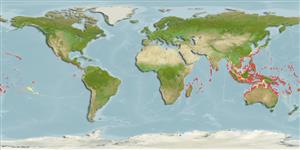Actinopterygii (ray-finned fishes) >
Perciformes (Perch-likes) >
Lethrinidae (Emperors or scavengers) > Monotaxinae
Etymology: Gnathodentex: Greek, gnathos = jaw + latin, dens, dentis = teeth (Ref. 45335).
Environment / Climate / Range
Ecology
Marine; reef-associated; non-migratory; depth range 3 - 30 m (Ref. 9710). Tropical, preferred ?; 35°N - 30°S
Indo-Pacific: East Africa to the Tuamoto Islands (excluding the Hawaiian Islands), north to Japan, south to Australia. Recently reported from Norfolk Island (Ref. 8880).
Size / Weight / Age
Maturity: Lm ? range ? - ? cm
Max length : 30.0 cm TL male/unsexed; (Ref. 2295); common length : 20.0 cm TL male/unsexed; (Ref. 2295)
Inhabits subtidal reef flats, lagoons, and seaward reefs (Ref. 9710). May be solitary or in groups (Ref. 90102). Sometimes forms aggregations of about a hundred or more individuals. Feeds at night on benthic invertebrates like crabs and gastropods, occasionally on small fish. Usually marketed fresh.
Life cycle and mating behavior
Maturity | Reproduction | Spawning | Eggs | Fecundity | Larvae
Carpenter, K.E. and G.R. Allen, 1989. FAO Species Catalogue. Vol. 9. Emperor fishes and large-eye breams of the world (family Lethrinidae). An annotated and illustrated catalogue of lethrinid species known to date. FAO Fish. Synop. 125(9):118 p. Rome: FAO. (Ref. 2295)
IUCN Red List Status (Ref. 115185)
CITES (Ref. 94142)
Not Evaluated
Threat to humans
Reports of ciguatera poisoning (Ref. 4690)
Human uses
Fisheries: commercial
More information
Common namesSynonymsMetabolismPredatorsEcotoxicologyReproductionMaturitySpawningFecundityEggsEgg development
ReferencesAquacultureAquaculture profileStrainsGeneticsAllele frequenciesHeritabilityDiseasesProcessingMass conversion
Tools
Special reports
Download XML
Internet sources
